

A relatively young designation as compared to other US highways in Pennsylvania, this one did not appear in the Commonwealth until 1935. The designation followed the current US 202 alignment from Delaware to Business US 322 to enter West Chester on High Street. In downtown West Chester it changed course to follow Gay Street and then Paoli Pike to the village of the same name where it was multiplexed with US 30 to the current PA 252 to New Centerville. From there it was signed on Swedesford Road to King of Prussia where it rejoined was is the current alignment through to Norristown where it was signed on DeKalb Street. Between Norristown and Doylestown, it followed the current alignment but in the latter it continued through the downtown area on State Street and returned to the current alignment. West of New Hope, it turned onto the current PA 179 to travel into New Jersey.
In 1938, the route was widened on its multiplexes with US 30 in Paoli and US 309 between Montgomery Square and Montgomeryville. In the following decade, the widening work took place in Bridgeport in 1946 from Henderson Road to the Schuylkill River.
The 1950s were more eventful in the life of US 202. In 1953, the route was split in Norristown with southbound traffic utilizing Johnston Highway, Markley Street, and Lafayette Street while northbound traffic continued to utilize DeKalb Street. Construction on the first section of expressway began from Business US 322 to the US 322 west interchange in the West Chester area in 1954 and opened the following year. Also in 1955, the route was widened from King of Prussia to Henderson Road and from Schoolhouse Road to Gwynedd. The US 202 designation was moved onto the West Chester Bypass from Business US 322 to the Paoli Pike interchange. In 1958, the route was widened at the West Chester Bypass, in Doylestown, and in New Hope while a median was installed on the section between Schoolhouse Road and Gwynedd. A median was installed on the section between the Delaware state line and Business US 322 in 1959.
If the 1950s saw more activity on the route than the previous decades, the 1960s would continue the trend. In 1964, the Pennsylvania Department of Highways proposed constructing an expressway paralleling the US 202 corridor from Delaware to New Jersey. The 59 mile-long expressway, which was referred to as the Piedmont Expressway in planning reports, would cost $146 million and serve as an outer beltway for the Philadelphia area. The Department of Highways divided the project into eight sections, and placed seven of them on their six-year improvement program. It was not the first time a plan like this would be proposed. In 1932, a plan to build a parkway roughly along the route of US 202 was proposed by the then Regional Planning Federation, now the Delaware Valley Regional Planning Commission, but never got off the ground.
Construction on the next segment of expressway began in 1965 from the PA 252 interchange to the I-76 interchange and was completed in 1967 as was a median installation from I-76 to Gulph Road. In 1968, construction began on the section from US 30 to the PA 252 interchange and a year later, work began on the part from the US 322 interchange to US 30.
The 1970s began with the opening of the expressway from US 322 to PA 100 and US 30 to PA 252 in 1970. The remainder between PA 100 and US 30 opened to traffic in 1971, and with it the designation was removed from its old routing and placed onto the expressway. Also opening that same year was the 1,682-foot-long New Hope-Lambertville Toll Bridge on July 22, 1971. With endings also came beginnings in 1971 as construction began on the Doylestown Bypass from Main Street to Pebble Hill Road. In 1972, construction began on the southbound bridge over the Schuylkill River and extended from Pebble Hill Road to PA 313 on the Doylestown Bypass. A median was construction from Gulph Road to the northbound/southbound split in Norristown. The first segment of the Doylestown Bypass opened to traffic in 1973 from Main Street to the existing US 202 alignment east of the borough.
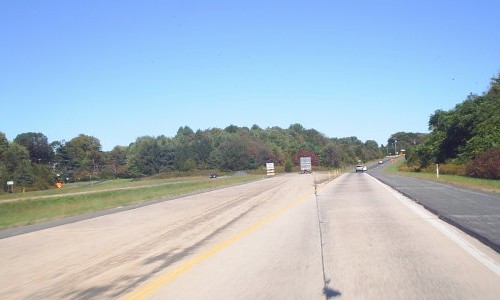
Stub ramp at East State Street east of Doylestown which would have
continued the
Piedmont Expressway to New Jersey. (Doug Kerr)
In 1975, the designation was moved out of New Hope onto the New Hope-Lambertville Toll Bridge and signed on what was to be a temporary roadway to connect the old alignment to the bridge. Built in 1973, the highway was to have been replaced by the cancelled Piedmont Expressway. Construction began in 1975 on the rest of the Doylestown Bypass from US 202 west of Doylestown to Main Street which opened in its entirety the following year. The new Schuylkill River bridge and roadway for southbound US 202 from Norristown to the original US 202 alignment opened as well in 1976. Good and bad news in 1977 with the good news being the designation was removed from Doylestown and placed on the bypass. The bad news was PennDOT withdrew funding for the expressway segment through Bucks County due to opposition from residents who saw it as a truck bypass and would destroy the rural quality in the county. That is the reason for the stub ramps at the US 202/PA 611 interchange south of Doylestown. Another section to get the fiscal axe was the planned segment from Upper Merion Township to Montgomery Township in Montgomery County.
Another segment that would not see the light of day was from Valley Forge to Lower Gwynedd Township. The expressway would have taken one of two paths: the existing alignment would be upgraded to an expressway or another route paralleling PA 363 that would bypass Norristown utilizing the US 422 expressway and rejoin the US 202 near the Pennsylvania Turnpike-Northeast Extension.
The planned expressway alignment from the Delaware state line to the southern end of the West Chester Bypass seems to be the forgotten one. It would have parallel the existing US 202 alignment to the west. An interchange with the cancelled US 1 expressway would have been constructed in the vicinity of the Brandywine Battlefield State Park. This expressway would have continued into Wilmington to provide access to I-95 and another cancelled highway the DE 141 Expressway. However, no right-of-way was purchased for this section.
In 1978, ramps were constructed on the new southbound highway at PA 23 for the proposed Schuylkill Parkway, but were revamped in 1986 after the project was scrapped.
In 1983, the Delaware Valley Regional Planning Commission recommended building the US 202 expressway from Doylestown south to a proposed extension of the Fort Washington Expressway near Lansdale. In 1989, another study by the commission concluded that the expressway could use existing land set aside for the construction, thus preventing personal properties being acquired for the project. PennDOT began engineering and environmental studies along this section in 1990. The original route was to be 10.5 miles, but was shortened to 8.9 miles in the mid-1990s. Approval for this new highway came from the Federal Highway Administration on August 27, 1998.
The 1990s saw improvements take place along the route. In the late 1990s, PennDOT spent $3.6 million to rebuild 2.6 miles of the route from King of Prussia to Bridgeport. On March 16, 1999, PennDOT began work on rebuilding the section of US 202 from Tredyffrin Township, Chester County to Upper Merion Township, Montgomery County. The process began in 1986 with environmental impact studies along the route, with preliminary designs in the early 1990s, and concluded with PennDOT receiving final engineering and environmental design approval from the Federal Highway Administration in 1996.
The project consisted of widening the existing expressway to six lanes from North Valley Road to Gulph Road. New bridges were built at Old Eagle School Road and South Warner Road as well as new sound barriers installed and drainage improvements occurred.
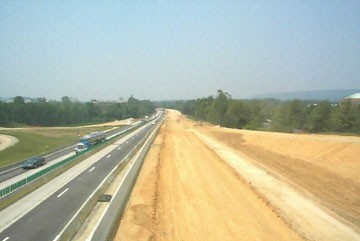 Grading for the new highway (PennDOT) |
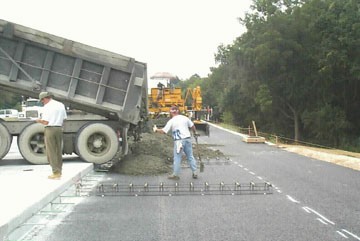 Pouring the concrete (PennDOT) |
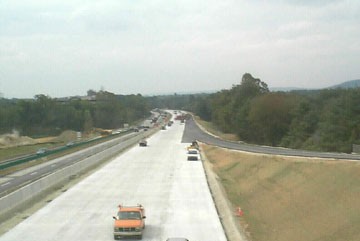 Placing the finishing touches (PennDOT) |
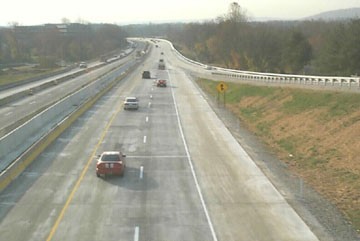 The new highway open to traffic. (PennDOT) |
The interchange between US 202, US 422, and I-76 was rebuilt so weaving would be decreased. A new ramp from US 202 northbound to I-76 eastbound and a new collector-distributor highway now provides access from US 202 southbound to US 422 and I-76. The new ramp opened to traffic on December 13, 2001, at that time the former ramp from northbound US 202 to eastbound I-76 closed.
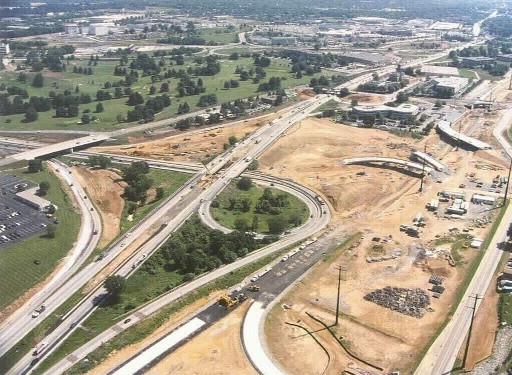 Collector-distributor ramp system under construction at the US 422 interchange. (PennDOT) |
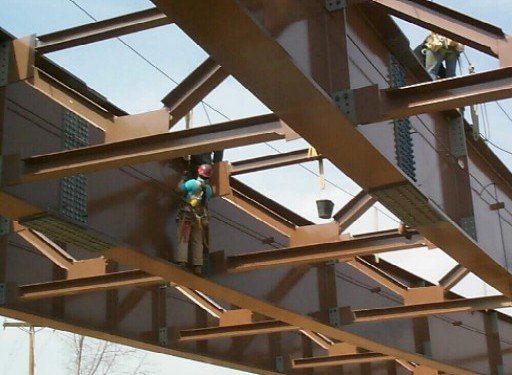 Workers standing on bridge beams over new ramp. (PennDOT) |
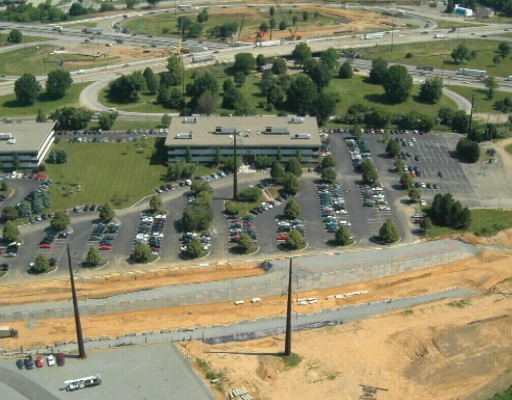 Construction of the new ramp from US 202 north to I-76 east. (PennDOT) |
In early 2001, sinkholes proved to be a problem within the interchange. They had been anticipated, which PennDOT planned $30,000 for sinkhole mitigation due to disturbing the top soil. Some of them were 150-feet-deep and forced emergency work to be performed to stabilize them by pumping grout into the voids, as was done at the Mid-County Interchange project on the Turnpike which is located nearby. So much grout was needed that a production facility was built at the site. The cost of the work was $17 million and reached to nearly ten times the original projected price when the work ended.
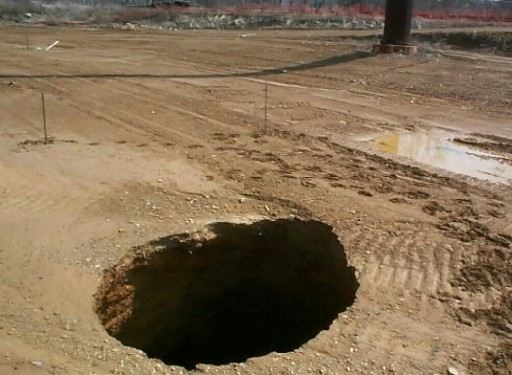 Sinkhole at the US 422 interchange. (PennDOT) |
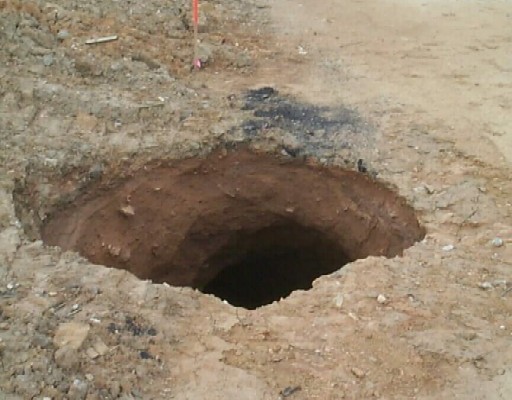 Another sinkhole at the US 422 interchange. (PennDOT) |
Part of the interchange opened in early 2002. Other interchanges rebuilt were the Chesterbrook Boulevard interchange in Paoli with Chesterbrook Boulevard being extended south to PA 252. Swedesford Road interchange and the Valley Forge Road interchange saw minor improvements.
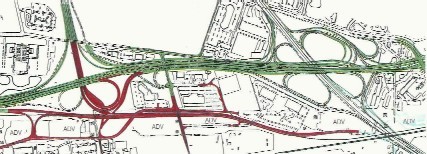
Green indicates lanes and ramps to
be reconstructed
or reconfigured; red indicates new lanes and ramps to be
constructed on new alignment. (PennDOT)
One of the more challenging aspects of the project was the moving of the historic King of Prussia Inn, which used to sit in the median of US 202 just north of the I-76 interchange. In August 2000, the inn was moved from the old location to Bill Smith Boulevard in Upper Merion.
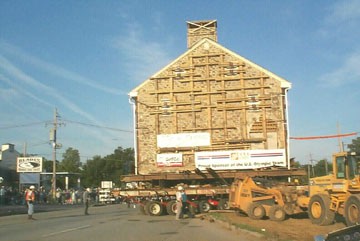 |
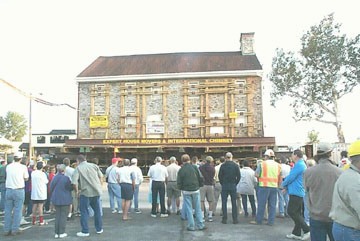 |
| Two views of the historic King of Prussia Inn's move in August 2000. (PennDOT) | |
The $290 million project concluded at 10:30 AM on October 30, 2003, when Pennsylvania Transportation Secretary Allen Biehler cut the ribbon signaling the rehabilitation was completed.
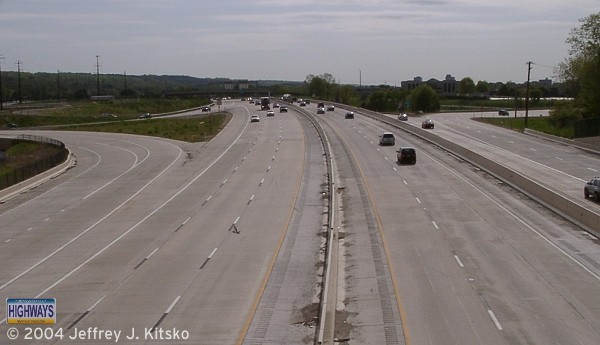
Looking southbound from the Old Eagle School Road overpass onto the rebuilt
section.
From the New Hope-Lambertville Toll Bridge's opening in 1971 until December 1, 2002, tolls were collected in both directions. On that day, tolls in the northbound, or New Jersey-bound, direction were eliminated.
On June 16, 2005, PennDOT announced work would begin on a $13.6 million project to install ITS equipment on US 202 in Delaware and Chester Counties. The $14.7 million project finished in June 2008 after crews installed 33 closed circuit TV cameras, 22 dynamic message signs, and 61 incident detectors along the route as well as PA 100 and US 30 in Chester County. The equipment is connected to the Philadelphia Traffic Management Center in King of Prussia.
The Montgomery Township, Montgomery County to Doylestown Township, Bucks County section of the US 202 expressway that was discussed in the late-1980s and early-1990s and approved in 1998 was slated to begin in 2003. The then $280 million "new alignment alternative" would have consisted of four 12 foot-wide lanes and grades kept at a maximum of four percent with a design speed of 65 MPH. Interchanges were planned to be built at PA 63, PA 309, County Line Road, Bristol Road, and PA 611. The project was slated to be completed in late 2006. However, with PennDOT restructuring their 12-Year Transportation Program, the project is now being reevaluated which prompted a study entitled "A Look At New Solutions" in April 2004. The project alternative which spells out a $161 million, two-lane parkway to be built in Section 700 was announced on February 16, 2005. Neither PennDOT nor the Delaware Valley Regional Planning Commission have the necessary $383 million to build the expressway that was discussed through most of the 1990s. Neighbors for Bucks County Preservation, a local advocacy group, favored an option that used roundabouts, but that idea was not suited for congestion management.
On September 14, 2005, Governor Edward Rendell announced the restart of acquiring land for the Section 700 project. "Today I am directing the Department of Transportation to move forward with the planned improvement along the US Route 202 Section 700 corridor," Governor Rendell said. "The people of this region have waited for decades for state government to relieve congestion along this corridor. We are now moving forward with an affordable and practical solution."
Ground was broken on November 21, 2008
for the 100% state-funded, $200 million project included construction of a four-lane,
at-grade roadway between PA 63 and PA 463 and a two-lane parkway between PA 463 and PA
611, five-foot paved shoulders/bicycle lanes, new traffic signals at nine
intersections, left turns at all intersections, 11 new bridges and overpasses,
12-foot-wide bicycle/walking path, five trailhead parking areas, stylized barriers,
culverts, retaining walls and bridge surfaces to simulate a traditional, stone
appearance, landscaped medians and other aesthetic enhancements. Construction began a month later on
the Southern Section from PA 63 to PA 463, the first of three phases of parkway
construction, which cost $31.7 million and stretches 1.8
miles. Construction on the 3.3-mile, $25 million Central Section (PA 463 to Pickertown Road) and
3.4-mile, $42.2 million Northern Section (Pickertown
Road to PA 611) began on January 21, 2010 and January 18, 2010 respectively.
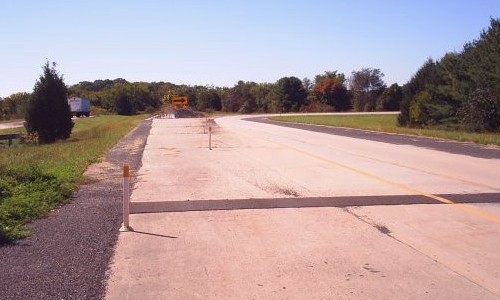
The former stub ramp southwest of Doylestown at PA
611 where
the
US 202
Parkway connects to the existing US 202. (Doug Kerr)
Lieutenant Governor Jim Cawley and Secretary of Transportation Barry J. Schoch joined local officials to open the US 202 Parkway on December 3, 2012. "Today we usher in a new transportation era in Bucks and Montgomery counties with the opening of the Route 202 Parkway," Cawley said. "The state’s newest roadway brings a badly needed infusion of capacity along this busy corridor to help reduce congestion and enhance traffic flow." Upon opening, it was designated Pennsylvania's 20th Scenic Byway. "This designation will help us preserve the scenic views commuters, bicyclists and pedestrians will enjoy when traveling on this new and beautifully landscaped parkway in southeastern Pennsylvania," said Secretary Schoch.
Construction is underway on improving more of the existing expressway farther south in Chester County. PennDOT divided the project into four contracts: the first began in March 2007 and consisted of replacing the Swedesford Road, Church Road, and Mill Lane and improving the PA 401/Phoenixville Road, Phoenixville Road/Planebrook Road/Swedesford Road intersections which wrapped up in Fall 2008. The second contract involved modifying the Swedesford Road, PA 29, and abandoned railroad bridges, and replacing the Cedar Hollow Road bridge which began in February 2008 and finished in Summer 2010. The third contract is to widen the four-lane expressway to six lanes from US 30 to North Valley Road, rebuild seven overpasses to increase horizontal and vertical clearances, building new collector-distributor ramps for the PA 29 interchange, new ramps for the PA 401 interchange, installation of traffic cameras and variable message signs, upgrading drainage system, and building sound walls at various locations where needed which began April 21, 2011 with a groundbreaking attended by transportation Secretary Barry J. Schoch, P.E., and federal, state, and local officials. "Today we launch construction on a highly anticipated project that will transform an aging and worn stretch of Route 202 into a modern six-lane highway," Schoch said. "When completed, this expansion will help keep commuters moving safely and smoothly through the Great Valley area." The $295.8 million project began in 2007 and is expected to finish in late 2015. Project website: http://www.us202-300.com/.
Sinkholes are a problem in the King of Prussia area, and one rear its ugly head on February 4, 2011. A 75-foot-wide section of pavement sank six inches in the northbound lanes around 5 AM near the King of Prussia Mall, forcing Upper Merion police to close the road until the problem could be evaluated and repairs made. Upon investigating the sinkhole, PennDOT crews discovered a water main and a sewer main break compounding the problem. To make matters even worse, on that afternoon, it was learned that the sinkhole extended into the southbound lanes as well which necessitated closure of those. About 200 yards of concrete was pumped into the hole to stabilize the area, then it was covered with about 10 inches of asphalt before the roadway was reopened around 5 PM the following day.
The Delaware River Joint Toll Bridge Commission was also looking to improve their section of US 202. In April 2013, the Commission awarded a contract for rehabilitation of the New Hope-Lambertville Toll Bridge with work beginning soon after. The project included rehabilitation, repair, and repaving US 202 approaches to the bridge and on-/off-ramps at PA 32 and NJ 29; repointing, joint sealing, and concrete repairs to the bridges over PA 32 and NJ 29; sealing the decks of all three bridges; and cleaning and painting of all lights and overhead sign structures. One of the unique aspects of the project was this marked the first time the DRJTBC used emulsified foamed asphalt, a new paving technique that involves recycling most of the former surface, instead of milling and repaving with new asphalt. The $12.9 million project concluded in Fall 2013.
When the Coronavirus, or COVID-19, pandemic swept into the country in March 2020, the Delaware River Joint Toll Bridge Commission took measures to stem the spread to their employees and staff. At 10:00 PM on March 24, all tolled bridges, including the New Hope-Lambertville Toll Bridge, went to a cashless toll collection system. E-ZPass users would pass through the plazas as normal, and drivers who normally paid by cash were directed to the far right lane of the toll plazas and to have their license plate captured. A bill for the toll only, without additional administrative or violation fees, would then be sent to their address which would then have to be paid within 30 days or else each unpaid transaction would face a $30 violation fee. At 11 PM on May 13, the DRJTBC began accepting cash payments again. Additional safety measures were put in place, such as toll collection staff being given plastic face shields, masks, and nitrile gloves. They also encouraged drivers paying by cash to wear a face covering when using a cash lane.
The year 2023 was not a good one for the route through King of Prussia as not one, but two sinkholes opened up on DeKalb Pike. On the night of July 10, the roadway was closed in both directions following the discovery of a sinkhole after a reported water outage in the area. Crews from Pennsylvania American Water repaired the water main, filled the hole with aggregate and stones, wrapped it all in a geotextile fabric to stabilize the ground, replaced the road surface and lane markings. US 202 reopened around 8:20 PM on July 12. However, the northbound left lane had to be closed once again between Henderson Road and Saulin Boulevard on the night of July 15 due to new pavement failure, with the right lane closing the following night around 11:15 PM. Work to discover the cause began on July 18 and finished on July 24. The reason for the length of the closure was because the stronger materials needed to fix the issue which needed longer times to set. It was determined that this hole was caused by the recent heavy rains which dissolved limestone and other material underneath the roadway.
Work has begun on Rt 202 in KOP. PennDOT is trying to figure out why newly laid asphalt is sinking in the same spot of a water main break and sinkhole last week. 202 NB remains closed. @NBCPhiladelphia pic.twitter.com/k5GUqD9L9Y
— Matt DeLucia (@MattDeLucia) July 18, 2023
Five months later, multiple sinkholes would be discovered under the same section of roadway. The first sinkhole was discovered under the right lane of the northbound side just north of the Hendersonville Road intersection, leading to the closure of both northbound lanes on December 14. The following day, the southbound direction was closed entirely between Saulin Boulevard and Henderson Road due to the discovery of multiple sinkholes under both lanes. After backfilling of the voids and resurfacing work, the northbound right lane was reopened on December 16. The northbound and southbound left lanes were reopened on December 19, with the southbound right lane opening in the afternoon of December 20. PennDOT will continue to monitor this section to determine if additional subsurface stabilization work needs to be performed.
This afternoon, the right lane on U.S. 202 South (Dekalb Pike) was reopened between Saulin Boulevard and Henderson Road in King of Prussia, Montgomery County, following sinkhole repairs. All lanes are now open on U.S. 202 in this work area. https://t.co/XT7nmr2BHw pic.twitter.com/iZgrzim4BX
— 511PA Philadelphia (@511PAPhilly) December 20, 2023
It was an end of an era for the New Hope-Lambertville Toll Bridge on June 16, 2024 when cash payments stopped being accepted at 11 PM. This span, along with the Portland-Columbia and Milford-Montague toll bridges, were the first Delaware River Joint Toll Bridge Commission tolled spans to switch to all-electronic tolling (AET) utilizing only E-ZPass and TOLL BY PLATE for payments. A design contract to replace the toll plazas with gantries that have E-ZPass readers and TOLL BY PLATE cameras was awarded at the Commissions's June 24, 2024 meeting to Rummel, Klepper & Kahl, LLP (RK&K) of King of Prussia to develop two gantry designs: one for low-traffic volume toll bridges, such as the New Hope-Lambertville, and another for high-traffic-volume toll bridges like the Interstate 78 span.
With the end of cash tolls on Delaware River Joint Toll Bridge Commission bridges came the end of the toll plazas themselves. The agency awarded its first contract to demolish the plaza at the New Hope-Lambertville Toll Bridge in April 2025. Work to demolish the toll plaza, which also includes removing the "jog" on US 202 northbound at the toll plaza and reconstructing the median barrier at that point, build an overhead gantry with E-ZPass toll reading equipment and cameras to record license plates for toll-by-plate collection near the location of the toll plaza, and repairs to the abutment backwall on the Pennsylvania side began on June 23. This will be the first DRJTBC span where its toll plaza is replaced with Open Road Tolling (ORT). The $11.6 million project is expected to be completed by late winter/early spring 2027.
Links:
Exit Guide
US 202 Auxiliary Routes
US 202 Pictures
US 122
(Decommissioned)
E-ZPass - Delaware River Join Toll Bridge Commission
New Hope-Lambertville Toll Bridge
- Delaware River Joint Toll Bridge Commission
Doylestown
Bypass - Steve Anderson
Terminus
of US 202 - Dale Sanderson
US 202 Expressway -
Steve Anderson
US 202
Pictures - Andy Field/Alex Nitzman
US 202
Pictures - Steve Alpert
US
Route 202 - David Golub
 INFORMATION
INFORMATION |
| Southern Entrance: | Delaware state line three-quarters of a mile south of Johnsons Corners |
| Northern Entrance: | New Jersey state line at the New Hope-Lambertville Toll Bridge in New Hope |
| Length: | 58.70 miles |
| National
Highway System: |
Entire length |
| Names: | Wilmington Pike, DeKalb Street (northbound), West Johnson Highway (southbound), Markley Street (southbound), DeKalb Pike, US 202 Parkway, Doylestown Bypass, Buckingham Road, York Road, and Lower York Road |
| SR Designation: | 0202 |
| Counties: | Delaware, Chester, Montgomery, and Bucks |
| Expressway: | Business US 322 to I-76 PA 611 to Business US 202 |
| Multiplexed Routes: |
US 322: US 1 to West
Chester PA 152: Chalfont PA 263: Buckingham to Lahaska |
| Former Designations: |
PA 22 (1927 - 1928): Delaware state line to West Chester PA 52 (1927 - 1928): King of Prussia to Business US 202 and Business US 202 to PA 179 PA 12 (1927 - 1928): PA 309 south to PA 463 US 122 (1928 - 1935): Delaware state line to Business US 322, King of Prussia to Business US 202, and PA 313 to PA 179 |
| Former LR Designations: | 135 Spur: Delaware state line to PA 491 135: PA 491 to Business US 322 775: Business US 322 to US 322 West 1042: US 322 West to Gulph Road in King of Prussia 143: Gulph Road to Main Street in Norristown 46126: US 202 to Swede Road (southbound) 143 Parallel: Main Street to US 202 (southbound) 178: Main Street to Business US 202 1062: PA 611 to Business US 202 152: Business US 202 to PA 143 152 Spur: PA 143 to PA 263 155: PA 263 to PA 179 1086: PA 179 to Lower York Road |
 Pennsylvania Byway: |
Business US 202 to PA 611 |